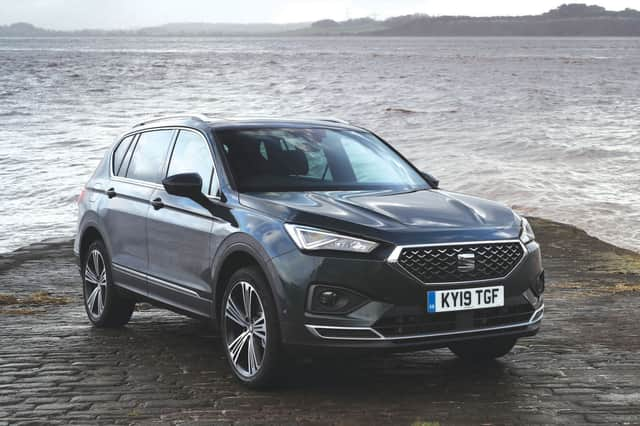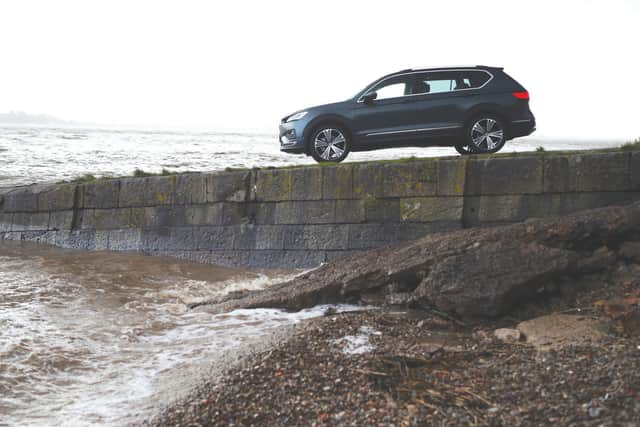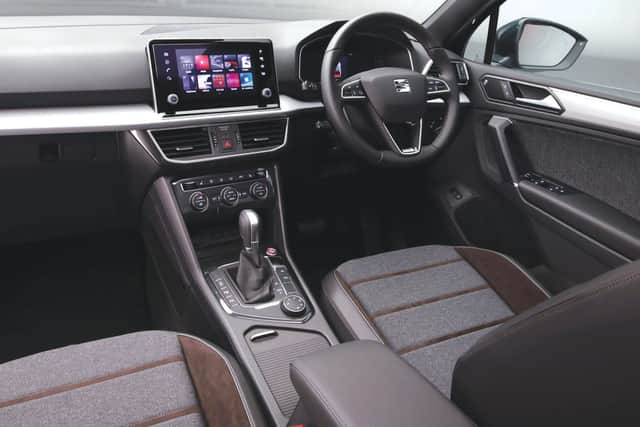MOTORS REVIEW: Seat Tarraco


The Seat brand had one notable gap left to fill going into this summer and with the arrival of the Tarraco all anxiety about the Catalonian brand’s absence of a large SUV capable of carrying seven occupants has abated…and breathe.
Strip back that rather feline front end and the distinctive strip of red plastic that conjoins the rear light clusters and the Tarraco is immediately identifiable as a Volkswagen Group product.
Advertisement
Hide AdAdvertisement
Hide AdIn silhouette — and those trademark double shoulder-line creases running down each flank — the family resemblance between it, the VW Tiguan Allspace and the Skoda Kodiaq are immediately apparent.
Prices for the Tarraco start at £28,550 for the 150PS 1.5-litre petrolpowered front-wheel-drive SE trim and top out with the £40,090 Xcellence First Edition+ with four-wheeldrive and a 190PS diesel and DSG dual clutch gearbox.
As such, it starts out some £2,215 less than the equivalent Tiguan but almost £6,000 more than the less wellequipped and less powerful five-door entry-level to the Kodiaq line-up.
This is Seat’s flagship and it has rivals like the Peugeot 5008 and bigboned Kia Sorento in its sights, though…
Advertisement
Hide AdAdvertisement
Hide AdWe tested the upper-mid-range Xcellence trim Tarraco with the rangetopping drivetrain of 190PS two-litre turbodiesel, 4drive all-wheel-drive and that DSG gearbox, which comes in at £36,545.


So equipped, Seat claims fuel economy of 38.2 to 39.2mpg and CO2 emissions of 188g/km alongside a potential 9.8 second dash to 62mph and 123mph.
Seat’s drive profile system allows the driver to select Normal, Eco, Sport and Individual modes, with off-road and snow settings for 4Drive versions like the one tested here.
Unfortunately we had no opportunity to put the Tarraco through its paces on the rough stuff.
Advertisement
Hide AdAdvertisement
Hide AdThe performance from the Tarraco’s 190PS turbodiesel felt a little underwhelming to me.
This is an engine which I have been blown away by in smaller VW vehicles in the past and I felt that its 400Nm of torque would mean that it could fair hustle the larger SUV along, but in truth it felt rather staid, its diesel timbre entering the cabin a little more than expected when pushed.
The seven-speed DSG gearbox, as ever, was smooth as you like once up and running but could be hesitant from a standstill and, in conjunction with stop/start, the combination of waiting for the engine to start and the gearbox to select its ratio before getting underway could be a little tiresome.
Seat’s determination to offer something a little more sporty than its mainstream VW siblings means that its suspension is on the firmer side, but this translates nicely into added control rather than an uncomfortable ride.
Advertisement
Hide AdAdvertisement
Hide AdThe Tarraco rides well, in fact, with a nice balance between cornering composure — it exhibits little lean for a car that can feel a little heavy under acceleration — and a comfortable ride which smooths out the worst road imperfections.
Passengers are treated to an interior which is easily marked out as Seat’s flagship offering.


In the Xcellence trim tested here Baza Grey cloth with Brown Alcantara inserts looked great and combined with a sleek eight-inch touchscreen sat-nav infotainment system — equipped with Apple CarPlay and Android Auto smartphone connectivity — and instruments laid out in logical VW-fashion which function well.
Among the Xcellence trim’s perks are heated front seats, an array of USB charging ports, including one in the back alongside zone-specific climate control dials and adaptive cruise control.
Advertisement
Hide AdAdvertisement
Hide AdThe Taraco’s interior is rather typical VW fayre. It feels of higher quality than its Seat siblings, with quality soft-touch plastics and well-judged highlights of brushed metal, while all the controls function intuitively and without fuss.
Seat’s “Digital Cockpit” instrument cluster dispenses with traditional dials in favour of a 10.2 inch screen, is configurable but some options for the screen are quite hard to read and render the vital speed readout rather too small for my liking.
Overall, the Tarraco’s interior lacks a distinctive stamp to mark it out as being a Seat and it lacks the flair and imagination of the 5008’s attractive i- Cockpit set-up.
As well as ranking highly on quality the Tarraco can also compete on practicality, though, and a second row of seats split 40:20:40 giving access to a third row of two seats capable of accommodating smaller children or small adults for very short journeys.
Advertisement
Hide AdAdvertisement
Hide AdSeat claims boot capacity of 230- litres with all the seats in place or a useful 700-litres with the third row folded flat, but it never seemed that cavernous in practice, the arm rests of the rearmost seats cutting into the load area a little.
I left the Tarraco appreciating it for what it is — Seat’s unquestionable flagship model.
It delivers VW build quality with its own more feline Seat face, an engaging drive and levels of seven-seat practicality to rival the others in the sector.
Perhaps the only question is whether customers will forego the stylish Peugeot 5008, be willing to save cash on the more premium branding of a VW Tiguan or the temptation to save money and buy a Skoda Kodiaq to step into the Spanish brand’s top contender…